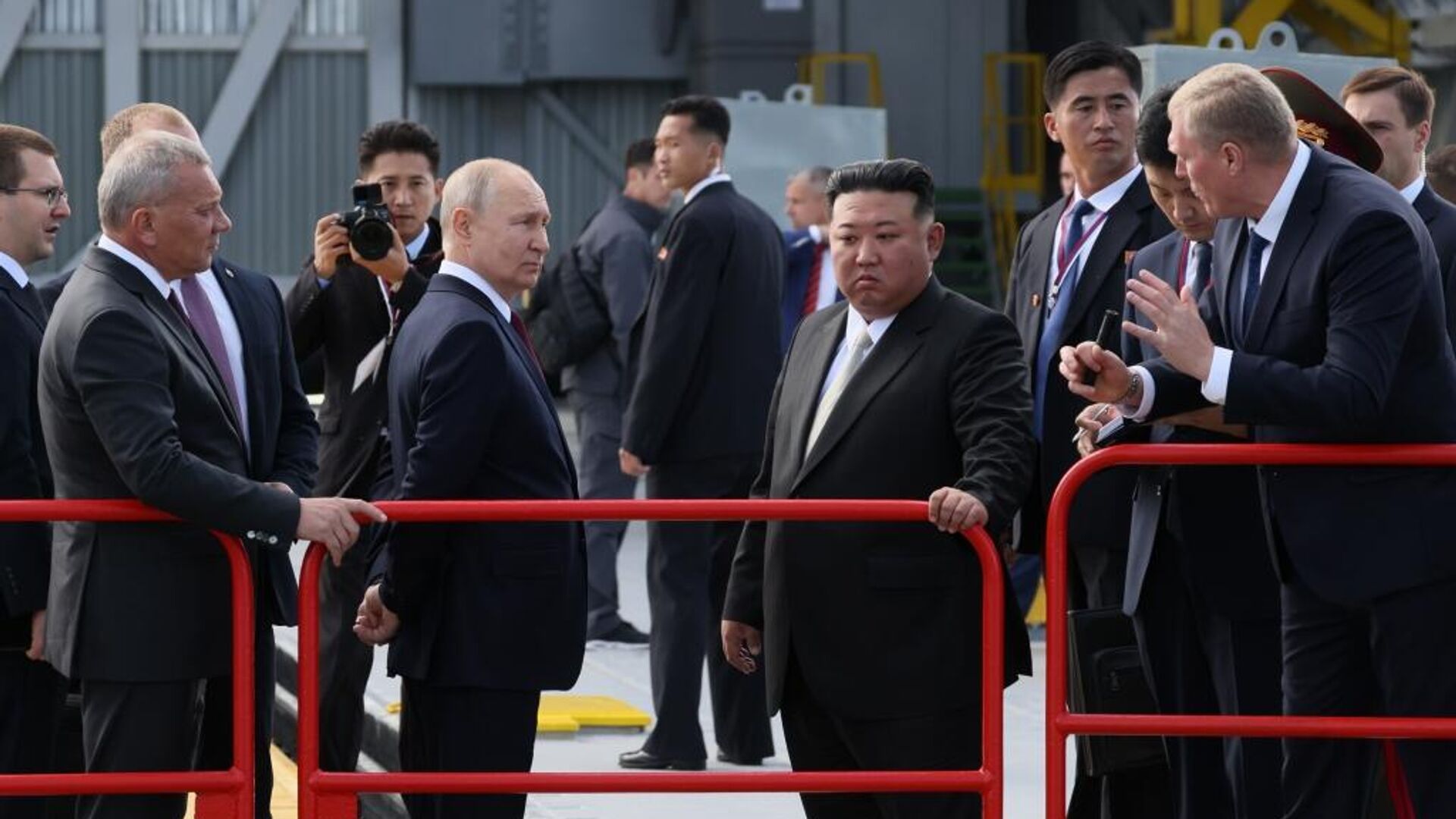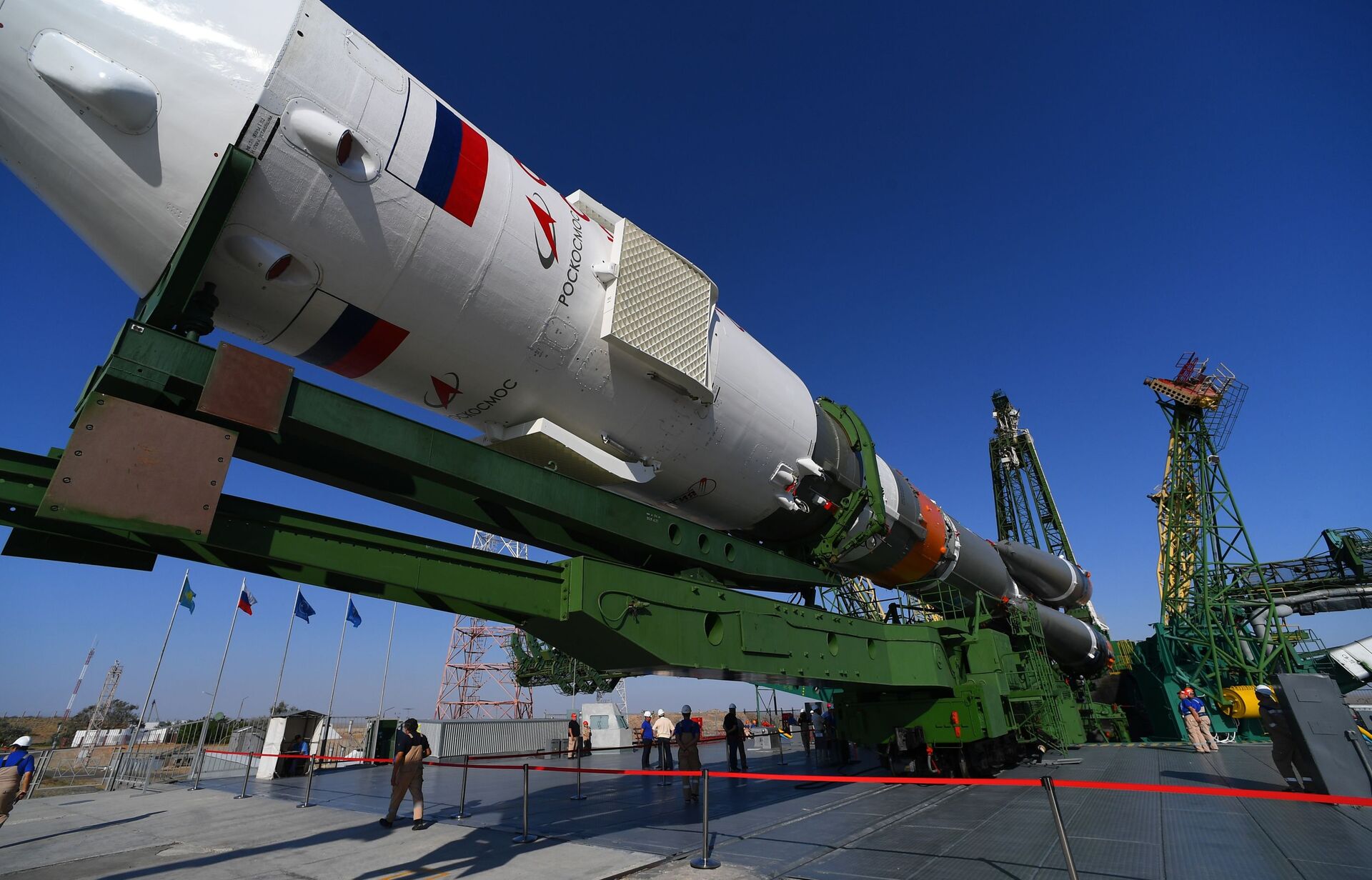https://sputnikglobe.com/20230913/which-rockets-did-putin-and-kim-see-at-the-vostochny-cosmodrome-1113335130.html
Which Rockets Did Putin and Kim See at the Vostochny Cosmodrome?
Which Rockets Did Putin and Kim See at the Vostochny Cosmodrome?
Sputnik International
During a meeting with Kim Jong Un, Vladimir Putin, in particular, said that he is proud of how space field is being developed in Russia.
2023-09-13T09:32+0000
2023-09-13T09:32+0000
2023-09-18T13:34+0000
world
russia
vladimir putin
putin-kim jong un meeting
booster
rocket
north korea
https://cdn1.img.sputnikglobe.com/img/07e7/09/0d/1113337359_0:52:1024:628_1920x0_80_0_0_d39afe88156b7b973e93f3744f73c182.jpg
Russian President Vladimir Putin and North Korean leader Kim Jong Un started their meeting with a tour of the Soyuz-2 space rocket launch facility at the Vostochny Cosmodrome in the Russian Far East’s Amur region.The two leaders were briefed on the progress in the assembly of a new Angara booster, as well as on the characteristics of the Soyuz-2 launch vehicle.They visited the installation and test facility, where one of the technical rooms was completely modernized for the assembly of the Angara rocket.Soyuz 2 Rocket Putin noted that apart from the Vostochny and Plesetsk spaceports, Russia also continues using the Baikonur Cosmodrome to launch the Soyuz 2 rockets.Kim, in turn, was interested in the characteristics of the Soyuz rockets, including their engine power. He was told that the lifting capacity of the rocket to low orbits is nine tons if the booster is launched from the Vostochny Cosmodrome.According to Putin, it is more effective compared to the launch of a rocket from the Plesetsk or Baikonur spaceports.The refueling of launch vehicle tanks takes place from stationary oxygen, nitrogen, kerosene, and naphthyl units. The decision to run the filling hoses underground was made for safety reasons. The total area of the Soyuz-2 complex is 25,000 square meters.Soyuz-2 is a family of three-stage medium-class launch vehicles, developed and produced by the Progress missile space center based in the Russian city of Samara.The booster’s family also includes the two-stage light class Soyuz-2.1v launch vehicle.The Soyuz-2 launch vehicle is internationally known for its high reliability, multitask capability and orbital insertion accuracy. The rocket remains the basic launch vehicle for manned missions to the International Space Station.Angara RocketCurrently, the construction of a launch pad for the Angara rockets is near to being completed, a facility that will enable scientists from the Vostochny Cosmodrome to implement programs on exploring the solar system and beyond.The facility has an area of 109 hectares and includes a 28-meter-high launch structure, a command post, oxygen, as well as nitrogen and naphthyl technological units and water storage tanks."Angara" is a family of the latest Russian modular launch vehicles of various payloads, created on the basis of universal rocket modules fitted with oxygen-kerosene engines.The family includes launch vehicles from light to heavy classes with a payload ranging from 3.5 tons (Angara-1.2) to 38 tons (Angara-A5V) in low Earth orbit.Notably, the Angara rocket does not use aggressive or toxic fuel components, which adds significantly to improving environmental safety, both in the areas adjacent to the launch complex and territories where the expended spent stages of launch vehicles fall.
russia
north korea
Sputnik International
feedback@sputniknews.com
+74956456601
MIA „Rossiya Segodnya“
2023
Oleg Burunov
https://cdn1.img.sputnikglobe.com/img/07e4/09/0b/1080424846_0:0:2048:2048_100x100_80_0_0_3d7b461f8a98586fa3fe739930816aea.jpg
Oleg Burunov
https://cdn1.img.sputnikglobe.com/img/07e4/09/0b/1080424846_0:0:2048:2048_100x100_80_0_0_3d7b461f8a98586fa3fe739930816aea.jpg
News
en_EN
Sputnik International
feedback@sputniknews.com
+74956456601
MIA „Rossiya Segodnya“
Sputnik International
feedback@sputniknews.com
+74956456601
MIA „Rossiya Segodnya“
Oleg Burunov
https://cdn1.img.sputnikglobe.com/img/07e4/09/0b/1080424846_0:0:2048:2048_100x100_80_0_0_3d7b461f8a98586fa3fe739930816aea.jpg
russian president vladimir putin, north korean leader kim jong un, talks between russian president vladimir putin and north korean leader kim jong un, vostochny cosmodrome, soyuz 2 booster, angara booster
russian president vladimir putin, north korean leader kim jong un, talks between russian president vladimir putin and north korean leader kim jong un, vostochny cosmodrome, soyuz 2 booster, angara booster
Which Rockets Did Putin and Kim See at the Vostochny Cosmodrome?
09:32 GMT 13.09.2023 (Updated: 13:34 GMT 18.09.2023) During a meeting with Kim Jong Un, Vladimir Putin said that he is proud of how the space field is being developed in Russia.
Russian President Vladimir Putin and North Korean leader Kim Jong Un started
their meeting with a tour of the Soyuz-2 space rocket launch facility at the Vostochny Cosmodrome in the Russian Far East’s Amur region.
The two leaders were briefed on the progress in the assembly of a new Angara booster, as well as on the characteristics of the Soyuz-2 launch vehicle.
They visited the installation and test facility, where one of the technical rooms was completely modernized for the assembly of the Angara rocket.
Putin noted that apart from
the Vostochny and Plesetsk spaceports, Russia also continues using the Baikonur Cosmodrome to launch the Soyuz 2 rockets.
Kim, in turn, was interested in the characteristics of the Soyuz rockets, including their engine power. He was told that the lifting capacity of the rocket to low orbits is nine tons if the booster is launched from the Vostochny Cosmodrome.
According to Putin, it is more effective compared to the launch of a rocket from the Plesetsk or Baikonur spaceports.
The Soyuz-2’s command post building can withstand the impact of falling component stages of the launch vehicle, and the facility’s massive walls and ceiling are designed to protect personnel from a potential accident.
The refueling of launch vehicle tanks takes place from stationary oxygen, nitrogen, kerosene, and naphthyl units. The decision to run the filling hoses underground was made for safety reasons. The total area of the Soyuz-2 complex is 25,000 square meters.
Soyuz-2 is a family of three-stage medium-class launch vehicles, developed and produced by the Progress missile space center based in the Russian city of Samara.
The booster’s family also includes the two-stage light class Soyuz-2.1v launch vehicle.
The Soyuz-2 launch vehicle is internationally known for its high reliability, multitask capability and orbital insertion accuracy. The rocket remains the basic launch vehicle for manned missions to the International Space Station.
Currently, the construction of a launch pad for
the Angara rockets is near to being completed, a facility that will enable scientists from the Vostochny Cosmodrome to implement programs on exploring the solar system and beyond.
Yury Borisov, head of the Russian space agency Roscosmos, earlier announced that the launch complex for Angara rockets would start operating before the end of this year.
The facility has an area of 109 hectares and includes a 28-meter-high launch structure, a command post, oxygen, as well as nitrogen and naphthyl technological units and water storage tanks.
"Angara" is a family of the latest Russian modular launch vehicles of various payloads, created on the basis of universal rocket modules fitted with oxygen-kerosene engines.
The family includes launch vehicles from light to heavy classes with a payload ranging from 3.5 tons (Angara-1.2) to 38 tons (Angara-A5V) in low Earth orbit.
Notably, the Angara rocket does not use aggressive or toxic fuel components, which adds significantly to improving environmental safety, both in the areas adjacent to the launch complex and territories where the expended spent stages of launch vehicles fall.





